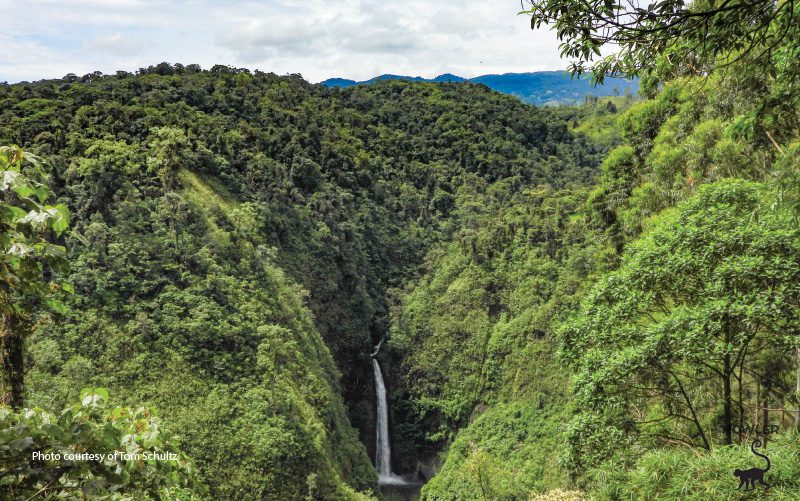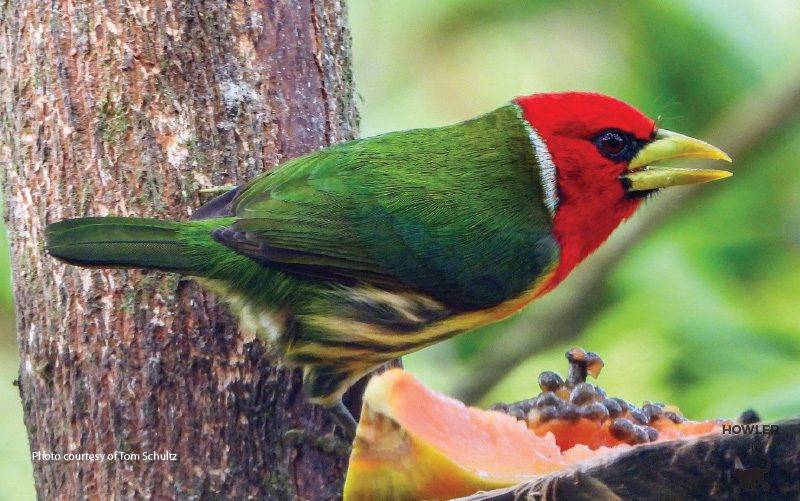[vc_row][vc_column][vc_column_text]
Soda y Mirador Cinchona or Colibri Cafe: More Than Just Great Food. One of the ways to experience the real Costa Rica is to dine in a “soda,” Tico slang for a small restaurant or diner. The etymology of this seemingly Spanglish name is unclear. Many believe it is derived from fuente de soda (soda fountains), popularized in North America from the 1920s to 1950s. Costa Rican sodas are typically small, locally owned and operated eateries where there is no menu, or at best merely a list of items scrawled on a chalkboard. What you can count on is tipico (typical) fare, a great way to savor the local scene and cuisine. (Learn more about sodas in the March 2019 issue of Howler.)

There are literally thousands of sodas in Costa Rica, practically one on every corner. That means finding the “best” one is purely subjective, but here’s my personal favorite: Soda y Mirador Cinchona, also known as Colibri Cafe. It has the perfect combination of history, local culture, scenery, nature, and what I think is the best tortilla con queso in the country. But I am getting ahead of myself. Let’s start at the beginning.
Disaster strikes
On January 8, 2009 at 1:21 pm, a magnitude 6.1 earthquake occurred directly under and near the La Paz Waterfall and small town of Cinchona. The earthquake instantly took at least 34 lives, left 64 people missing and injured 91. Most of the fatalities resulted from a landslide near the La Paz Waterfall, where 452 people — including 369 tourists — had to be evacuated by helicopters. Cinchona was devastated: every building was heavily damaged and almost 1,300 people were displaced. In addition, roads and bridges were destroyed, notably the scenic wooden bridge at the bottom of the La Paz waterfall, replaced by today’s less-than-scenic Bailey Bridge. This earthquake is still considered one of the biggest disasters in Costa Rica’s history.
Risen from the ruins
The large, two-story Cinchona soda was already well known in 2009. It was totally destroyed in the quake and ensuing landslides when more than 2,000 aftershocks were registered. Unlike the town itself, now called Nuevo Cinchona, which was relocated and rebuilt a few kilometers away at Cariblanco de Sarapiquí, Alajuela, the soda’s landmark roots are more firmly embedded than ever. The family owners opted to rebuild their popular dining spot on the same steep slope that remained under the rubble, with the new soda a tad more rustic and smaller than the original. So if plucky stubbornness and resilience are what it takes to get you there, your visit to this iconic eatery will make you understand why it was rebuilt on the same location.

Take route 126 north from the Central Valley, winding down past the Peace Lodge and La Paz Waterfall Gardens. Cross the bridge at the bottom of the falls and drive up the other side. The unassuming soda will be on your right. If it’s not a busy day, you can park right in front, but otherwise be prepared for tourist vans and buses. As you walk in, a small souvenir area on your right also contains photographs from the earthquake, while the kitchen is on your left. Straight ahead you will see tables and the two main reasons for coming to this soda: the waterfall and the birds!
A key reason for not relocating the Soda y Mirador Cinchona may now be obvious: it is the perfect mirador — viewing location — for the San Fernando Waterfall. Plunging over 70 meters (almost 250 feet), it empties out of the Barva Volcano at Braulio Carrillo National Park into the steep gorge cut by its own outflow and the La Paz Waterfall. It’s an exquisite place to sit, drink coffee and enjoy the beauty.

Birding mecca
The second important reason for retaining the soda’s original building site relates to its alternate name, Colibri Cafe. Colibri is Spanish for “hummingbird,” and this eatery is renowned for offering an extraordinarily easy and rewarding bird-watching experience. Fruit feeders and hummingbird feeders attract perhaps the most amazing assemblage of birds in any one spot this small, anywhere in Costa Rica if not Latin America. It’s a mecca that birding and nature tour groups in the vicinity should never miss. Hummingbirds of almost countless varieties dazzle you as they work the flowers and feeders: from the tiny green thorntails to the country’s largest hummingbird, the violet sabrewing, they will likely appear. So too is it common to see rare and endemic hummingbirds here, and other species on many a birder’s “lifer” list. Toucans, toucanets and barbets — stunningly beautiful creatures that are typically hard to find — flock around you. Strikingly colorful tanagers, almost too numerous in species to count, squawk at each other by the fruit feeders. Even raptors like the beautiful white hawk seem to know everyone is watching as they soar by the overlook.
Popularity has prompted the soda owners to charge for use of the bathrooms, and a photography fee if you are not there to eat. That is understandable given the number of visitors there solely for the view. But do stay and eat — it’s the last best reason for going to Soda y Mirador Cinchona!

Fabulous food
The menu is on the wall, but recently table menus have become available too. Everything is tipico, although you can get omelettes for breakfast. All the food is cooked a la lena, on wood-powered stoves. Coffee is made one cup at a time with the classic Costa Rican “sock” (chorreador) coffee maker. All the food is good, but one menu item stands out above the rest — the tortilla con queso.
As a vegetarian, I am usually limited in the selections to order at typical sodas, and gallo pinto can only be eaten so many times. Then a Costa Rican friend told me to order the tortilla con queso at the Colibri Cafe. He rated it the best in the country. Once I tried it, I totally agreed. But if you want one for breakfast, get there early before they run out. On our last recent trip, I got the last one of the morning!
So, for the fascinating history, stunning nature, spectacular birds and fabulous food, do yourself a favor and make a day trip to Cinchona. You’ll enjoy time well spent sitting, sipping coffee, indulging in a natilla-covered tortilla con queso, soaking in the beauty of the falls, and delighting in the wonderful floor show the colorful birds put on for you. Maybe you’ll leave in agreement that it’s your favorite soda in the country.
[/vc_column_text][/vc_column][/vc_row][vc_row][vc_column][vc_empty_space height=”20px”][vc_tta_accordion active_section=”0″ collapsible_all=”true”][vc_tta_section title=”Flamingo area articles” tab_id=”1586003698930-a641e6ea-7c90″][vc_column_text]
Getting to know Flamingo
Playa Flamingo Now and Then
[/vc_column_text][/vc_tta_section][vc_tta_section title=”Adventure Articles” tab_id=”1586003698985-3864f4bd-7589″][vc_column_text]Diamante: Went for adventure and found Costa Rica culture too
Ecotourism in Costa Rica: Sustainable Tourism
Ecotourism Pioneer: Rafael Gallo – Ríos Tropicales
Caminos de Osa: Costa Rica Tourism that Helps Costa Ricans
Rincon de la Vieja – Things to do
4×4 Lake Arenal – road to El Castillo
Lucky Lovers Leap into an adventure of a lifetime
Lake Arenal – Lost Canyon Adventure
Gone Fishing: worst day fishing beats the best day working
Seven Days in Costa Rica: Arenal, Dominical and More
Lake Arenal: Safari River Float is a slow boat to paradise
Gone Sailing in Guanacaste Costa Rica
Cocos Island, Costa Rica’s treasure
Stand Up Paddle boarding SUP
ATV Tours, Take the road not taken
Deep Sea Fishing, Fun and Flamingo Costa Rica
White water rafting in Costa Rica
Scuba Diving in Costa Rica
Costa Rica Combo Adventure Parks
Authentic Costa Rica: What to do in rural Bijagua
Blue River Resort and Hot Springs[/vc_column_text][/vc_tta_section][/vc_tta_accordion][/vc_column][/vc_row]

